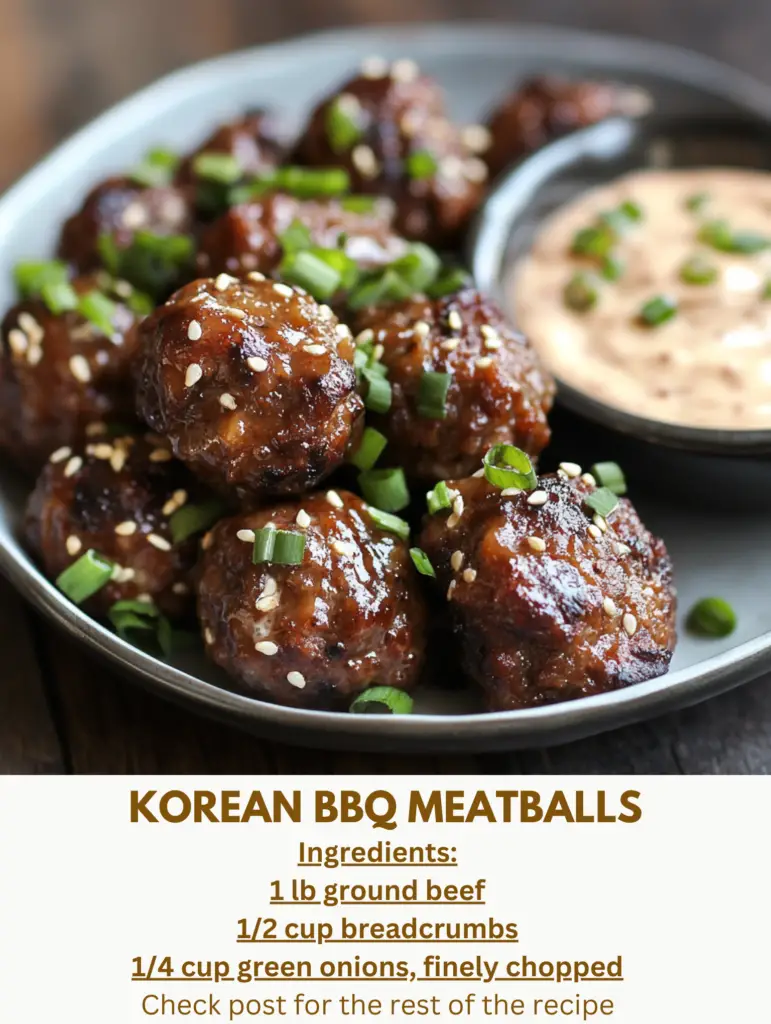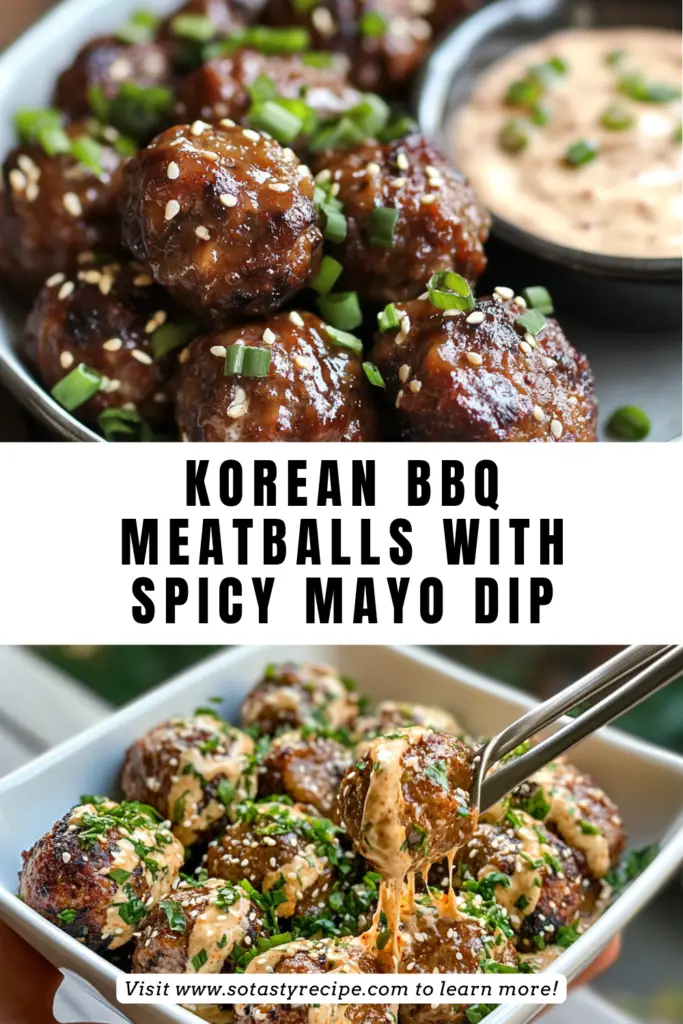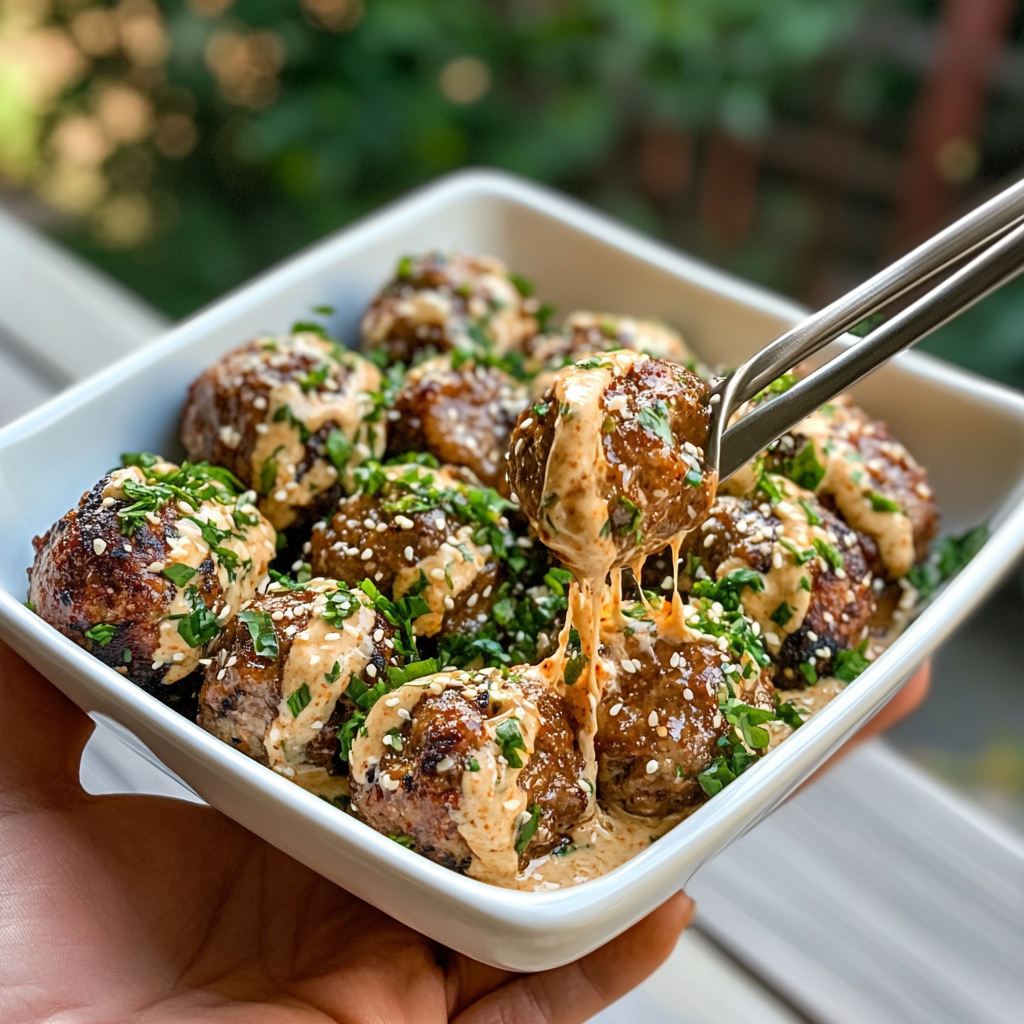Savory, spicy, and irresistibly flavorful, Korean BBQ meatballs with spicy mayo dip make the perfect crowd-pleaser.
Introduction
Korean BBQ meatballs with spicy mayo dip bring together the rich, umami-packed flavors of Korean cuisine in a bite-sized, easy-to-prepare dish. This recipe is perfect for weeknight dinners, family gatherings, or parties. The combination of tender meatballs glazed in a savory-sweet BBQ sauce and paired with a creamy, tangy, and spicy mayo dip makes this dish a showstopper. Keep reading to learn how to make this delectable treat, along with tips, variations, and accompaniments to elevate your cooking experience.

Definition
These Korean BBQ meatballs are juicy, tender, and coated in a mouthwatering homemade Korean-inspired BBQ sauce. The spicy mayo dip complements the meatballs by adding a creamy kick, balancing the sweet and savory notes of the dish. Each bite is packed with flavor, making it a hit with everyone.
Origin and History
Korean BBQ, or “gogi-gui,” has roots in ancient Korean cuisine. Historically, marinated meats were grilled on open flames or braziers. Over time, the rich flavors of gochujang (fermented chili paste) and soy sauce became hallmarks of Korean BBQ. Meatballs, though not traditional to Korean cuisine, borrow these iconic flavors, adapting them into a fusion-style dish popular in the U.S. and beyond.
Seasonal and Cultural Relevance
Best Season for the Recipe
While Korean BBQ meatballs can be enjoyed year-round, they are particularly popular during gatherings, holidays, and festive occasions when finger foods take center stage.
Cultural Relevance
This recipe draws inspiration from Korean BBQ traditions and is a nod to the global appreciation for Korean flavors. It’s a versatile dish that fits into Super Bowl parties, potlucks, and family dinners alike.
Key Ingredients
Meatballs
- Ground beef or chicken: Lean yet flavorful.
- Panko breadcrumbs: Ensure a tender texture.
- Garlic and ginger: Add depth and warmth.
- Green onions: A fresh, aromatic touch.
- Egg: Binds the ingredients together.
Korean BBQ Sauce
- Soy sauce: Salty and savory base.
- Gochujang: Adds spicy and umami richness.
- Brown sugar: Balances the heat with sweetness.
- Rice vinegar: Provides tanginess.
- Sesame oil: Nutty, aromatic flavor.
- Fresh garlic and ginger: Enhance the sauce’s complexity.
Spicy Mayo Dip
- Mayonnaise: Creamy base.
- Gochujang: Adds heat and flavor.
- Lemon juice: Brightens the dip.
- Sesame seeds: Optional garnish for added texture.
Nutritional Breakdown
- Protein: High in protein from meat.
- Vitamins: Includes B vitamins from the meat and vitamin C from the green onions.
- Minerals: Iron, potassium, and magnesium are present in many ingredients.
Preparation Steps
For the Meatballs
- Prepare the Mixture: Combine ground meat, panko, garlic, ginger, green onions, egg, salt, and pepper in a bowl.
- Form the Balls: Shape the mixture into 1-inch meatballs.
- Cook the Meatballs: Bake in a preheated oven at 400°F (200°C) for 20 minutes or until cooked through.
For the Korean BBQ Sauce
- Combine soy sauce, gochujang, brown sugar, rice vinegar, sesame oil, minced garlic, and ginger in a saucepan.
- Simmer on low heat until the sauce thickens slightly.
- Toss cooked meatballs in the sauce to coat evenly.
For the Spicy Mayo Dip
- Mix mayonnaise, gochujang, and lemon juice until smooth.
- Garnish with sesame seeds if desired.
Tools and Techniques
Essential Tools
- Mixing bowls
- Baking sheet
- Saucepan
- Whisk
- Measuring cups and spoons
Special Techniques
- Forming Even Meatballs: Use a cookie scoop to ensure uniform size for even cooking.
- Thickening the Sauce: Simmer on low heat to avoid burning while achieving the desired consistency.
Variations and Alternatives
- Protein Substitutes: Use turkey or plant-based ground meat for dietary preferences.
- Gluten-Free Option: Substitute panko breadcrumbs with gluten-free breadcrumbs.
- Milder Sauce: Reduce the amount of gochujang for a less spicy flavor.
- Vegetarian Version: Swap meat with mashed lentils and chopped mushrooms.
Pairings and Accompaniments
- Steamed rice
- Korean-style pickled vegetables (e.g., kimchi)
- Sesame broccoli or stir-fried greens
- Iced barley tea or a sparkling citrus beverage
Comparison with Similar Recipes
While classic meatballs often rely on Italian or Swedish flavors, these Korean BBQ meatballs stand out for their bold, umami-packed profile. They combine sweet, spicy, and savory elements that are distinct to Korean cuisine.
Health and Wellness Aspects
- High Protein: Great for muscle repair and energy.
- Low Sugar Option: Use less brown sugar or a natural alternative like stevia.
- Rich in Antioxidants: Gochujang and garlic provide antioxidants that boost immunity.

Frequently Asked Questions (FAQs)
What makes Korean BBQ spicy?
Gochujang, a fermented chili paste, is the key ingredient that provides heat and depth of flavor.
What meat is good in Korean BBQ sauce?
Beef, chicken, and even tofu work well with Korean BBQ sauce.
What is unique about Korean BBQ?
Its balance of sweet, savory, and spicy flavors, combined with communal grilling and eating, makes it special.
What three sauces are served at Korean BBQ?
Typically, sesame oil with salt and pepper, ssamjang (spicy dipping sauce), and soy-based sauces are common.
Best Time to Enjoy the Recipe
These meatballs are perfect for any meal but shine as appetizers or party snacks.
Storage and Leftovers
- Refrigeration: Store in an airtight container for up to 3 days.
- Freezing: Freeze uncooked meatballs for up to 3 months. Thaw and bake when needed.
- Reheating: Warm in the oven at 350°F (175°C) or on the stovetop.
Presentation Tips
- Serve on a platter with toothpicks for easy grabbing.
- Drizzle extra sauce over the meatballs for a glossy finish.
- Add a sprinkle of sesame seeds and chopped green onions for garnish.
Cooking for Specific Needs
- For dairy-free diets, ensure the mayo used is plant-based.
- Adjust the spice level by controlling the amount of gochujang.
Fun Facts and Trivia
- Gochujang has been used in Korean cooking for over 1,000 years.
- Meatballs are enjoyed globally, with each culture adding its own twist.
- Korean BBQ’s popularity in the U.S. surged in the 2010s due to food trucks and fusion cuisine.
Personalization and Storytelling
Feel free to experiment with different protein options or spice levels. These meatballs are a great canvas for culinary creativity. Share your own memories or ideas when serving them to friends and family.
Suggested Recipes
For more savory recipes you can also check my friend Alicia’s blog here.

